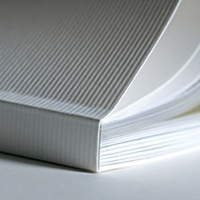Once your book is ready to hit the presses, there is a range of options to choose from in terms of paper stock, printing and binding.
Printing
Short book runs are generally ‘digitally’ printed. Long book runs undergo an ‘offset’ printing process. These days, the results are almost identical in quality. Offset printing is more economical per book but usually requires a minimum of 1,000 books to be printed.
Hardback printing
We have connections with experienced and reputable offshore printing companies to help you produce your hardback book.
Estimated turnaround time for most hardback books is 6-9 weeks from the sign-off of final artwork.
Contact us to view samples and discuss the options further.
Paperback square-back book binding
There are four main options if you wish your paperback book to have a spine:
1. Perfect Binding
Our most common form of binding, with perfect binding the spine is milled off the back of the sections, allowing the glue to adhere to the roughened edge of each individual leaf as the cover is attached.
2. Lock Binding
A special perforation allows the glue to adhere firmly to all pages in the section. Lock binding provides durability superior to burst binding and is an ideal alternative to very thin children’s books which may otherwise only be saddle-stitched.
3. Burst Binding
A line of 10mm x 1mm slots is cut from the spine at the fold. Sections are not milled before gluing. The glue adheres to the cut edge of each slot.
4. Section Sewing
The sections are folded without any spine perforation. Folded sections are collated and machine-sewn together with needle and thread to form a solid book block. The cover is then glued into position. This is the strongest square-back binding of all.
Other binding alternatives
1. Saddle-stitching
Also known as saddle-stapling, this is a more economical alternative to square-back binding, particularly for books under 36 pages (such as children’s books). Here, staples are pressed into the scored centre of the open book (where a spine would normally sit), after which they are folded to a flat finish. One advantage of saddle-stitching is that no printing is ‘lost’ in a spine when illustrations span across a double page.
2. Thermal binding
Ideal for short runs of hardback books, click here for more information on thermal binding.
3. Comb binding
Many songbooks and seminar workbooks are comb-bound, ensuring the book stays flat when opened. Click here for more information on comb binding.
